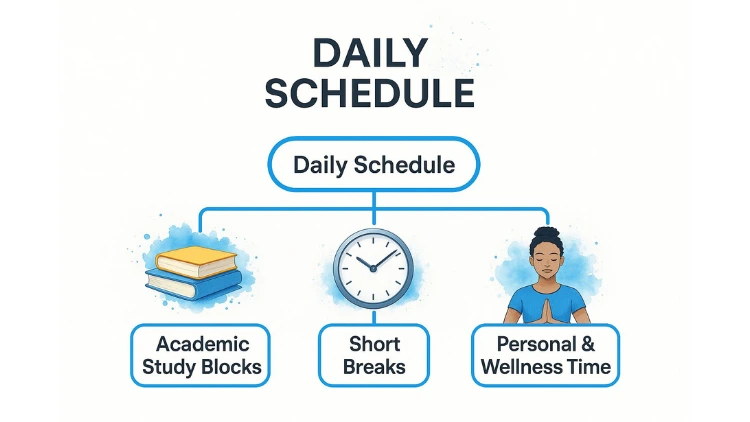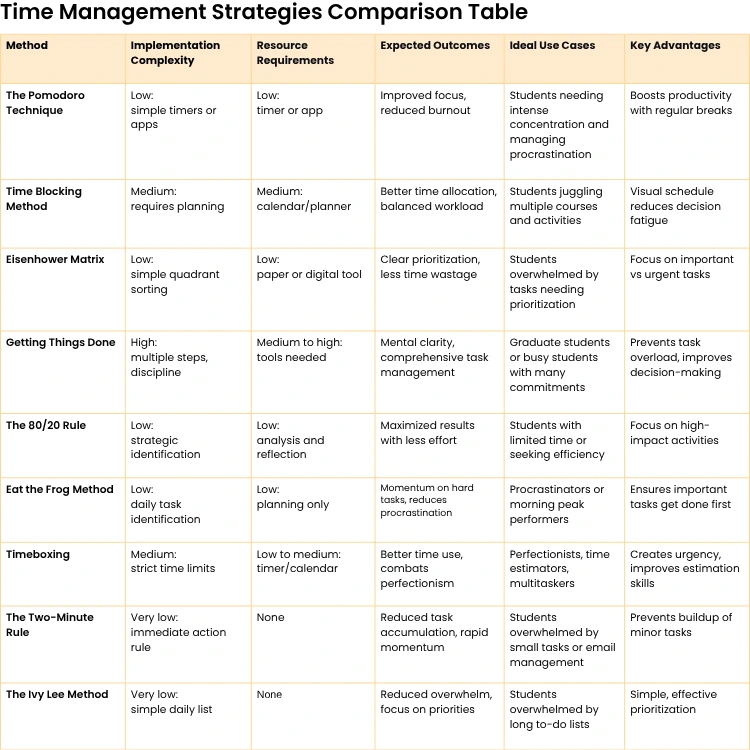Top Time Management Strategies Students Need in 2026

The life of a student is a constant balancing act between classes, assignments, exams, a social life, and maybe even a part-time job. Feeling overwhelmed is common, but it doesn't have to be your reality. The key isn't finding more hours in the day; it's mastering the ones you have. Effective time management is about creating systems that reduce stress, improve focus, and unlock your full academic potential, not about building rigid, joyless schedules. This article moves beyond generic advice to provide a deep dive into nine powerful time management strategies students can use to regain control.
We will explore frameworks like the Eisenhower Matrix for prioritization and techniques like the Pomodoro Technique for deep focus. Each strategy is broken down with actionable insights and practical examples tailored to a student's workflow, helping you move from theory to implementation immediately. For those looking for a broader overview before diving into these specific methods, these 8 Essential Student Time Management Tips offer a great starting point. Whether you're a procrastinator, a perfectionist, or simply feel there's never enough time, you'll find a system here to help you transform your study habits and achieve a healthier school-life balance.
Jump To Section

Earn As You Learn
Earn 25% commission when your network purchase Uplyrn courses or subscribe to our annual membership. It’s the best thing ever. Next to learning,
of course.
1. The Pomodoro Technique: Mastering Focus in 25-Minute Bursts
The Pomodoro Technique is a cyclical system that breaks down work into manageable, 25-minute intervals. Developed by Francesco Cirillo in the late 1980s, this method is one of the most effective time management strategies students can adopt to combat procrastination and improve concentration. It operates on a simple, yet powerful, premise: a large task is less daunting when viewed as a series of short, focused sprints.
The core of the technique is its structure. Each work interval, or "pomodoro", is followed by a short, five-minute break. After completing four pomodoros, you earn a longer break of 15-30 minutes. This rhythm of work and rest prevents mental fatigue, helping you maintain a high level of performance over a longer study session.
How to Implement It
Getting started with the Pomodoro Technique is straightforward and requires only a timer.
- Step 1: Choose a Task. Select one specific assignment.
- Practical Example: Instead of a vague goal like "study for chemistry", choose "Complete 10 practice problems for Chapter 3".
- Step 2: Set Your Timer for 25 Minutes. Commit to working on only that single task without interruption until the timer rings.
- Step 3: Work Until the Timer Rings. When it goes off, mark your progress and take a 5-minute break. This break should be a true mental reset—stand up, stretch, or grab a glass of water. Avoid checking your phone, as that can pull you out of your focused state.
- Step 4: Repeat. After the break, start another 25-minute pomodoro.
- Step 5: Take a Longer Break. Once you have completed four pomodoros, take a longer, more restorative break of 15 to 30 minutes. Use this time to check messages or grab a snack.
Actionable Insight: Treat the 25-minute block as sacred. Use a browser extension like "StayFocusd" to block distracting websites for the duration of your pomodoro. If an unrelated thought arises (e.g., "I need to email my professor"), jot it on a notepad to address later. This trains your brain to maintain uninterrupted focus.
2. The Time Blocking Method: Architecting Your Ideal Day
The Time Blocking Method is a scheduling strategy where you partition your entire day into specific, dedicated blocks of time. Popularized by productivity experts like Cal Newport, this approach moves beyond a simple to-do list by assigning every task a home on your calendar. This transforms your schedule into a clear, visual plan, ensuring that high-priority academic work, personal commitments, and rest are all accounted for.
By treating each block as a firm appointment, you create a structure that minimizes decision fatigue and combats procrastination. Instead of wondering what to do next, you simply consult your calendar and execute the assigned task. This method is one of the most powerful time management strategies students can use to take control of their schedule.
- Practical Example: A student might create these blocks: 9-11 AM: "Work on History Essay Outline"; 11-12 PM: "Gym"; 12-1 PM: "Lunch"; 1-3 PM: "Attend Biology Lecture & Review Notes".
How to Implement It
Getting started with time blocking requires a calendar, either digital (like Google Calendar) or physical.
- Step 1: Identify Your Priorities. At the beginning of the week, list all your fixed commitments (classes, labs) and major tasks (assignments, study sessions, exam prep).
- Step 2: Estimate Time for Each Task. Be realistic.
- Practical Example: If reading a chapter usually takes you 90 minutes, block out 105 minutes to include a small buffer.
- Step 3: Schedule Your Blocks. Drag and drop your tasks into your calendar. Place your most demanding academic work (like writing or problem-solving) during your peak energy hours (e.g., 10 AM-12 PM).
- Step 4: Include Buffers and Breaks. Schedule short, 10-15 minute buffer blocks between major activities to account for transitions or unexpected delays. This prevents one task running late from derailing your entire day.
- Step 5: Review and Adjust. At the end of each day, take five minutes to review your calendar. Did you stick to the plan? Which time estimates were wrong? Use this data to create a more realistic schedule for the next day.
This infographic illustrates a simple hierarchical structure for a student's daily schedule using time blocking.
The visualization shows how a balanced schedule gives equal structural importance to academics, rest, and personal well-being. By intentionally scheduling all three categories, you can manage your workload and prevent burnout.
Actionable Insight: Group similar, smaller tasks into a single block, a technique known as "batching". For instance, create a 60-minute "Communications" block to answer all emails, reply to discussion board posts, and return calls. This minimizes context switching and preserves your deep focus for major academic work. Learn more about how to manage your time and workload with ease by mastering this technique.

3. The Eisenhower Matrix: Prioritizing with Purpose
The Eisenhower Matrix is a decision-making framework that helps you categorize tasks based on two key dimensions: urgency and importance. This powerful tool is one of the most effective time management strategies students can use to move beyond simple to-do lists and make conscious choices about where to focus their energy. It prevents you from getting caught in a cycle of reacting to urgent, but ultimately unimportant, demands.
The matrix divides your tasks into four quadrants: Quadrant 1 (Urgent & Important), Quadrant 2 (Not Urgent & Important), Quadrant 3 (Urgent & Not Important), and Quadrant 4 (Not Urgent & Not Important). The goal is to spend most of your time on activities in Quadrant 2, which contribute to long-term goals, rather than constantly putting out fires in Quadrant 1.
How to Implement It
Using the matrix involves sorting your tasks and then acting on them based on their quadrant. For a deeper dive, you can explore more about planning and prioritizing using the time management matrix.
- Step 1: List Your Tasks. Write down everything you need to do, from studying for a final exam to responding to a group chat message.
- Step 2: Categorize Each Task. Assign each item to one of the four quadrants.
- Practical Example:
- Q1 (Do): "Finish essay due tomorrow."
- Q2 (Schedule): "Start research for term paper due in 4 weeks."
- Q3 (Delegate/Minimize): "Respond to non-urgent group project coordination emails" (delegate to the project lead or set a 15-min timebox).
- Q4 (Eliminate): "Endlessly scrolling social media feeds."
- Practical Example:
- Step 3: Act Accordingly. Address tasks based on their quadrant: Do Q1 tasks now, schedule Q2 tasks, delegate or minimize Q3 tasks, and eliminate Q4 tasks.
- Step 4: Review and Adjust. Revisit your matrix every Sunday evening to plan your week, ensuring you are dedicating enough time to important Q2 goals.
Actionable Insight: Proactively schedule your Quadrant 2 activities (e.g., "Work on final project outline for 1 hour") in your calendar before they become Quadrant 1 crises. True productivity isn't about being busy; it's about making progress on what truly matters for your long-term success.
4. The Getting Things Done (GTD) Method: Clearing Your Mental Clutter
The Getting Things Done (GTD) method is a comprehensive system designed to move tasks and ideas out of your mind and into a trusted external system. Developed by productivity consultant David Allen, this approach is one of the most powerful time management strategies students can use to manage overwhelming workloads. Its premise is that your brain is for having ideas, not holding them.
By capturing everything from assignment deadlines to random thoughts in an organized way, you free up mental bandwidth. This allows you to focus completely on the task at hand without the nagging feeling that you are forgetting something important. GTD provides a systematic workflow for processing your commitments, ensuring nothing falls through the cracks.
How to Implement It
Implementing GTD involves five core steps that turn chaos into an ordered, actionable system.
- Step 1: Capture. Collect everything that has your attention. Use a single digital app (like Todoist or Notion) or a physical notebook to capture every task, idea, and commitment.
- Practical Example: Capture "email Professor Smith about extension", "buy new highlighters", and "research summer internships".
- Step 2: Clarify. Process what you captured. For each item, decide if it's actionable. If it takes less than two minutes, do it immediately. If not, decide the very next physical action required (e.g., for the research paper, the next action is "find 3 primary sources at the library").
- Step 3: Organize. Put everything where it belongs. Schedule date-specific items on a calendar. File reference material (like class notes) in a dedicated folder. Add actionable items to context-based task lists (e.g., a list called '@Library' for tasks you can only do there).
- Step 4: Reflect. Conduct a "Weekly Review" every Friday afternoon. Go through all your lists, update your project progress, clear completed tasks, and get a clear overview of the upcoming week. This is the most critical step for maintaining the system.
- Step 5: Engage. Simply do. With a clear and current system, you can confidently choose which task to work on next based on your context (e.g., if you're on the bus, you can work on your '@Phone' list).
Actionable Insight: Start with the "2-Minute Rule". If you clarify an item and determine the next action will take less than two minutes (like confirming a meeting time via email), do it right then. This simple habit builds momentum and prevents small tasks from piling up. Organizing your next actions into a clear task list template for prioritizing will further enhance your focus.
5. The 80/20 Rule (Pareto Principle): Maximizing Results by Focusing on the Vital Few
The 80/20 Rule, also known as the Pareto Principle, suggests that roughly 80% of your results come from just 20% of your efforts. For students, this principle is a game-changer, transforming how you approach studying and assignments. Instead of trying to give equal attention to everything, it encourages identifying and prioritizing the high-impact activities that yield the most significant academic returns, making it one of the most strategic time management strategies students can employ.
This framework helps you strategically allocate your limited time and energy.
- Practical Example: A psychology student might realize that 80% of their exam questions are based on the core theories discussed in lectures (the 20% of content), while the supplemental readings rarely appear. They should focus their primary study time on mastering those lecture concepts.
How to Implement It
Applying the 80/20 Rule requires a shift from a "do everything" mindset to a "do what matters" approach.
- Step 1: Analyze Your Syllabus. Look at the grade weighting. If the final exam is 50% of your grade and weekly quizzes are 10%, your study time should reflect that high-impact distribution.
- Step 2: Identify High-Impact Study Methods. Track which study techniques lead to your best performance. You might discover that making and reviewing flashcards (the 20% effort) is far more effective for you than passively re-reading the textbook (the 80% effort).
- Step 3: Pinpoint Core Concepts. In any subject, certain fundamental concepts unlock understanding for everything else.
- Practical Example: In calculus, mastering derivatives is the vital 20% that makes understanding integrals much easier. Focus on mastering these key ideas first.
- Step 4: Review Past Exams. Look for patterns in question types and topics. This helps you identify the "vital few" areas your professor emphasizes.
Actionable Insight: At the start of each study session, ask yourself: "What is the single most important concept I can master right now that will have the biggest impact on my grade?" This forces you to identify and focus on the 20% of material that will deliver 80% of the results.

6. The Eat the Frog Method: Tackle Your Toughest Task First
The Eat the Frog method is a powerful productivity principle based on a quote attributed to Mark Twain: "Eat a live frog first thing in the morning and nothing worse will happen to you the rest of the day". In terms of time management strategies students can use, this translates to tackling your most challenging or dreaded task (your "frog") at the very beginning of your study session. This approach leverages your peak mental energy and willpower before they are depleted by other activities.
This strategy is highly effective because completing your most difficult assignment first creates a significant sense of accomplishment and momentum. The psychological boost makes subsequent, easier tasks feel much more manageable.
- Practical Example: If you dread starting the 15-page research paper for your literature class, "writing the introduction" becomes your frog. You tackle it before you even look at your math homework or answer emails.
How to Implement It
Putting this method into practice requires identifying your "frog" and committing to it before anything else.
- Step 1: Identify Your Frog. The night before, look at your to-do list and ask, "Which task am I most likely to procrastinate on?" That's your frog. It should be both important and challenging.
- Step 2: Prepare the Night Before. Set out all the necessary materials. If your frog is "Write chemistry lab report", open the necessary files on your computer and get out your lab notebook before you go to bed.
- Step 3: Eat the Frog First. As soon as you start your study time, begin working on that single, most challenging task. Do not check emails, social media, or work on easier assignments first.
- Step 4: Work Until It's Done. Focus solely on that task until it is complete. If the frog is too large (like an entire paper), your task could be "Complete the research and outline".
- Step 5: Move on with Confidence. With your biggest challenge of the day completed, you can move on to your other tasks with a sense of relief and productivity.
Actionable Insight: Protect your "frog-eating" time fiercely. If you have an 8 AM class, make your frog-eating session from 9 AM to 10 AM. Put it on your calendar, turn your phone on silent, and treat it as the most important appointment of your day. To delve deeper into tackling tough tasks, you can learn more about how to overcome procrastination.
7. Timeboxing: Setting Hard Limits for Maximum Efficiency
Timeboxing is a goal-oriented strategy where you allocate a fixed time period, or a "timebox" to a specific activity. Unlike open-ended work sessions, you stop when the time expires, regardless of whether the task is complete. This method is one of the most powerful time management strategies students can use to defeat perfectionism and prevent a single task from consuming an entire day. It creates artificial deadlines that force focus and promote rapid progress.
The core principle of timeboxing is to treat time as a fixed resource and adjust the scope of work to fit within it. By setting a hard stop, you are encouraged to prioritize the most critical components of a task.
- Practical Example: Instead of vaguely "studying for a history midterm", a student can set a 2-hour timebox with the specific goal of "creating a complete study guide for chapters 1-3". When the two hours are up, they stop and assess.
How to Implement It
Implementing timeboxing is a straightforward way to structure your study schedule and regain control over your workload.
- Step 1: Identify and Define the Task. Clearly define what you want to accomplish. Instead of "work on essay", be specific: "Draft the three body paragraphs for my English essay".
- Step 2: Allocate a Fixed Timebox. Estimate a reasonable amount of time and set a timer. This could be 45 minutes for reading a chapter or 90 minutes for drafting those paragraphs.
- Step 3: Work Exclusively on the Task. Focus solely on that activity until the timer goes off. The hard deadline forces you to avoid distractions and work efficiently.
- Step 4: Stop and Assess. When the time is up, stop working immediately. Evaluate your progress: Did you achieve your goal? Is what you've completed "good enough" for a first draft? This prevents perfectionism from taking over.
Actionable Insight: Use timeboxing for tasks you tend to avoid or over-perfect. For a task like "finding sources for a research paper", give yourself a strict 60-minute timebox. The urgency helps you make quick decisions and avoid falling down a research rabbit hole. This practice will dramatically improve your ability to plan future study sessions.
8. The Two-Minute Rule: Conquering Small Tasks Instantly
The Two-Minute Rule is a simple yet powerful principle for overcoming procrastination and reducing mental clutter. Popularized by productivity expert David Allen, this method is one of the most immediate time management strategies students can implement. The rule states: if a task takes less than two minutes to complete, do it immediately instead of postponing it.
This approach prevents the accumulation of small, nagging tasks that can collectively become overwhelming. For a busy student, handling these quick items right away clears mental space, allowing for deeper focus on more significant academic work.
- Practical Example: You finish a class and your professor mentions an upcoming quiz. Instead of just thinking "I should remember that", you immediately take out your phone and add the quiz date to your calendar. This takes less than two minutes.
How to Implement It
Integrating the Two-Minute Rule into your daily routine is about building a habit of immediate action for small tasks.
- Step 1: Identify the Task. When a new task arises, ask yourself: "Will this take less than two minutes?"
- Step 2: Act Immediately (If Yes). If the answer is yes, do it right there and then.
- Practical Examples: Replying to a professor's short email, signing up for a study group session, cleaning off your desk after a study session, or uploading a finished assignment.
- Step 3: Defer or Schedule (If No). If the task will take longer than two minutes, add it to your to-do list or schedule it in your calendar to be handled later.
- Step 4: Use it for Momentum. When you feel unmotivated to start a larger project (like studying for an exam), begin by completing a few two-minute tasks. This creates a sense of accomplishment and makes it easier to transition into more demanding work. For more on how these small wins boost your output, check out the importance of personal productivity.
Actionable Insight: Be honest about the two-minute estimate. The goal is to prevent small tasks from piling up, not to get sidetracked from deep work. If you are in a focused study session (like a Pomodoro), jot down the two-minute task and handle it during your next scheduled break to avoid breaking your concentration.
9. The Ivy Lee Method: Ruthless Prioritization for Maximum Impact
The Ivy Lee Method is a simple yet profoundly effective productivity system designed to eliminate decision fatigue and enforce focus. Developed over a century ago for steel magnate Charles M. Schwab, it remains one of the most powerful time management strategies students can use to cut through the noise of a busy schedule. Its brilliance lies in its forced prioritization and single-tasking approach.
The method requires you to identify and prioritize just six tasks for the next day. By pre-committing to your most important work, you start your day with a clear plan, preventing procrastination and the overwhelming feeling of not knowing where to begin. This structured approach ensures you are always working on what matters most.
How to Implement It
This method requires nothing more than a pen and paper or a simple notes app. The key is the daily ritual.
- Step 1: List Your Six Tasks. At the end of each day (e.g., 9 PM), write down the six most important things you need to accomplish tomorrow. Do not list more than six.
- Step 2: Prioritize the List. Review your six tasks and number them from 1 to 6 in order of true importance.
- Practical Example: 1. Finish Math Problem Set #5 (due tomorrow), 2. Read Chapter 7 for History, 3. Outline Sociology Paper, etc.
- Step 3: Start with Task #1. The next morning, begin working on your first task. Commit to working on it exclusively until it is complete. No multitasking.
- Step 4: Move Through the List. Once task #1 is finished, move on to task #2, then task #3, and so on. Continue this single-tasking focus.
- Step 5: Carry Over Unfinished Tasks. At the end of the day, any incomplete tasks are moved to your new six-item list for the following day, forcing you to re-evaluate their importance.
Actionable Insight: Be realistic when choosing your six tasks. If "write research paper" is on your list, break it down into a concrete, achievable first step, like "Draft the introduction for the research paper". The goal is to build momentum by completing tasks, not to create a list of overwhelming projects. This makes Task #1 something you can actually finish.

From Strategy to Success: Your Personalized Productivity System
We have explored a powerful arsenal of nine distinct time management strategies for students, from the structured focus of Time Blocking to the simple, action-oriented Two-Minute Rule. The journey from academic overwhelm to organized success doesn't lie in adopting a single, rigid method. Instead, the true power is unlocked when you become the architect of your own productivity system, blending these techniques to fit your unique academic demands and personal rhythms.
The goal is not to find the one "perfect" strategy but to create a flexible, personalized toolkit. True mastery of student time management comes from combining methods to solve specific challenges. You might use the Eisenhower Matrix at the start of each week to get a high-level view of your priorities, then create a daily Ivy Lee list of the top six tasks that emerged from your "Important and Urgent" quadrant. From there, you could apply the Pomodoro Technique to tackle each of those six tasks, ensuring deep focus without burnout.
Building Your Hybrid System: An Actionable Approach
Think of these strategies as building blocks. The key is to experiment intentionally and observe what works for you. Here’s a practical way to start:
- For the Overwhelmed Procrastinator: Start by combining "Eat the Frog" with "Timeboxing". Identify your most dreaded task for the next day (the frog) and schedule a non-negotiable 60-minute timebox to work on it first thing in the morning. This creates immediate momentum.
- For the Easily Distracted Planner: Use Time Blocking to structure your entire day, but integrate the Pomodoro Technique within each block. A three-hour study block for chemistry becomes five focused Pomodoro sprints with short breaks in between, keeping your mind fresh and engaged.
- For the Multitasker Drowning in Small Tasks: Implement the Getting Things Done (GTD) method to capture every single to-do, then apply the Two-Minute Rule to instantly clear out all the quick emails, replies, and administrative tasks that clog your mental bandwidth.
By consciously choosing and combining these time management strategies, students move from a reactive state of fighting fires to a proactive position of control. This intentional approach not only elevates your grades but, more importantly, carves out protected time for rest, hobbies, and social connections. Sustainable academic achievement depends on this balance. To truly optimize your academic output, it's essential to not only manage your time but also to improve how you perform key tasks. For instance, you can learn how to write more efficiently, significantly cutting down on assignment completion time.
Your journey toward effective time management is an iterative process of trial, error, and refinement. Pick one combination that resonates with you and commit to trying it for just one week. The small, consistent steps you take today are what build a foundation for a less stressful and more successful academic career.
Ready to take your skills to the next level with expert-led guidance? Explore the curated courses on Uplyrn to master productivity, conquer complex subjects, and achieve your academic goals. Find your perfect course and start learning smarter today at Uplyrn.


Leave your thoughts here...
All Comments
Reply